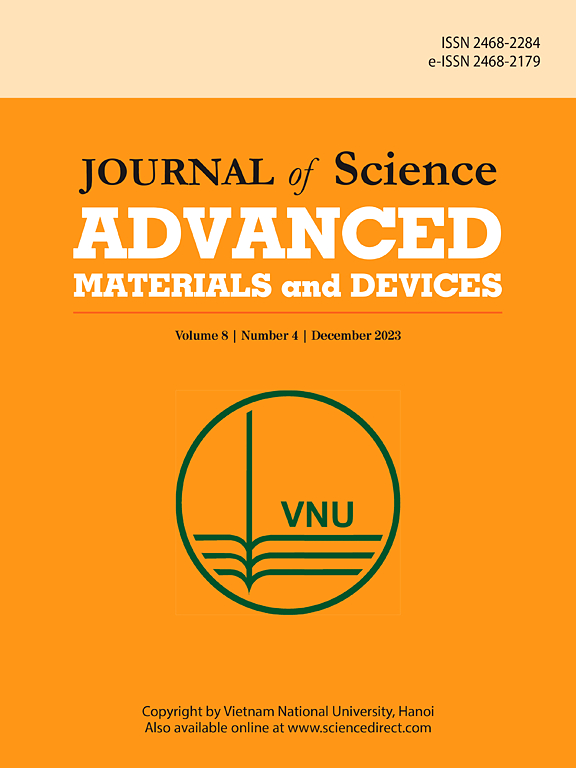ZnO/CuO纳米复合材料增强光催化和抗菌应用:合成方法的比较研究
IF 6.8
3区 材料科学
Q1 MATERIALS SCIENCE, MULTIDISCIPLINARY
Journal of Science: Advanced Materials and Devices
Pub Date : 2025-05-06
DOI:10.1016/j.jsamd.2025.100898
引用次数: 0
摘要
以扁桃叶提取物为稳定还原剂,通过生物途径制备ZnO/CuO纳米复合材料。通过化学沉淀法制备ZnO纳米粒子(NPs)和ZnO/CuO纳米粒子(NCs)进行比较。采用光谱、微观、电化学和XRD等技术对制备的样品进行了表征。此外,基于密度泛函理论(DFT)的第一性原理计算被用于阐明单个ZnO和CuO NPs的电子特性。x射线衍射(XRD)结果证实了制备的纳米粒子和纳米粒子的纯度和晶体特征。形态学分析表明,绿色介导的ZnO/CuO纳米碳纳米管的颗粒比不含提取物的纳米管更小,团聚度更低。比较了含植物提取物和不含植物提取物合成的ZnO/CuO纳米材料的光催化和抗菌性能。与化学合成的NCs相比,绿色介导的NCs对亚甲基蓝(MB)染料的分解表现出优越的可见光催化性能。特别是,在光催化80 min内,优化的绿色介导的NCs对MB的降解率达到98.80%,降解率为0.0528±0.00813 min−1。这种增强可能是由于颗粒尺寸减小,从而增加了绿色介导的nc的表面积。此外,绿色介导的ZnO/CuO NC对两种革兰氏阴性菌和两种革兰氏阳性菌的抑菌效果显著高于化学制备的NC样品。优化后的绿色介导NCs对大肠杆菌的最高抑菌带为19.0±0.37 mm。因此,生物合成的ZnO/CuO纳米材料具有实际和可持续的抗菌和光催化应用前景。本文章由计算机程序翻译,如有差异,请以英文原文为准。
ZnO/CuO nanocomposites for enhanced photocatalytic and antibacterial applications: A comparative study of synthesis methods
ZnO/CuO nanocomposites (NCs) were prepared through a biological route using Vernonia amygdalina leaf extract as a stabilizing and reducing agent. ZnO nanoparticles (NPs) and ZnO/CuO NCs were also fabricated via the chemical precipitation method for comparison purposes. Spectroscopic, microscopic, electrochemical and XRD techniques were employed to characterize the prepared samples. In addition, first-principles calculations based on density functional theory (DFT) were utilized to elucidate the electronic characteristics of the individual ZnO and CuO NPs. The X-ray diffraction (XRD) results affirmed the purity and crystalline features of the fabricated NPs and NCs. Morphological analyses demonstrated that the particles of green-mediated ZnO/CuO NCs are smaller and less agglomerated than those of NCs synthesized without the extract. A comparison of photocatalytic and antibacterial performances of ZnO/CuO NCs synthesized with and without plant extract was also conducted. Compared to chemically synthesized NCs, the green-mediated NCs exhibited superior visible light photocatalytic performance for the decomposition of methylene blue (MB) dye. In particular, the degradation of MB over the optimized green-mediated NCs reached 98.80 % within 80 min of photocatalysis, and the degradation rate was achieved as 0.0528 ± 0.00813 min−1. The enhancement might result from the reduced particle size and thereby the enhanced surface area of the green-mediated NCs. In addition, the anti-bactericidal effects of the green-mediated ZnO/CuO NCs against two Gram-negative and two Gram-positive bacteria were significantly higher than those of chemically prepared NC samples. The highest inhibitory zone was observed as 19.0 ± 0.37 mm against E. coli in the presence of the optimized green-mediated NCs. Thus, the biosynthesized ZnO/CuO NCs can be a potential candidate for practical and sustainable antibacterial and photocatalytic applications.
求助全文
通过发布文献求助,成功后即可免费获取论文全文。
去求助
来源期刊

Journal of Science: Advanced Materials and Devices
Materials Science-Electronic, Optical and Magnetic Materials
CiteScore
11.90
自引率
2.50%
发文量
88
审稿时长
47 days
期刊介绍:
In 1985, the Journal of Science was founded as a platform for publishing national and international research papers across various disciplines, including natural sciences, technology, social sciences, and humanities. Over the years, the journal has experienced remarkable growth in terms of quality, size, and scope. Today, it encompasses a diverse range of publications dedicated to academic research.
Considering the rapid expansion of materials science, we are pleased to introduce the Journal of Science: Advanced Materials and Devices. This new addition to our journal series offers researchers an exciting opportunity to publish their work on all aspects of materials science and technology within the esteemed Journal of Science.
With this development, we aim to revolutionize the way research in materials science is expressed and organized, further strengthening our commitment to promoting outstanding research across various scientific and technological fields.
 求助内容:
求助内容: 应助结果提醒方式:
应助结果提醒方式:


